How to Make Cold Brew Coffee at Home. You Will Love It!
Cold brew coffee is simple, inexpensive, and incredibly delicious. But what exactly is it? That mysterious beverage often served in a bottle — so creamy and so delicious, is vastly different from a regular iced coffee. To make truly outstanding cold brew coffee at home, we need to follow a few simple rules. In this article, we’ll take a deep dive into the world of cold brew — from brewing practices to the best coffee to use, and everything in between!
What is Cold Brew Coffee?
Put incredibly simply, cold brew coffee is brewing coffee using cold water, rather than hot.
Now, there are a few different variations and ways of doing this. A classic example of cold brew coffee is a simple cold immersion brew. Immersion brewing is when all of your ground coffee and all of your water are in the brewer at the same time, for the entire length of the brew. If you are familiar with the French press, then you have experienced immersion brewing first hand. But where French press and cold brew differ, is that cold brew is steeped using cold water for 16 hours, as opposed to using hot water and steeped for 4 minutes. This long, cold water extraction will produce a clean, smooth yet strong coffee in the cup, with less acidity and bitterness than a coffee brewed with hot water.
Cold brew coffee can also come in the form of a cold brew concentrate — a much stronger version of the immersion cold brew mentioned above. This concentrated version uses around three times the amount of dry ground coffee. When brewed into a liquid, concentrate can be diluted in the cup with ice and milk, soda, tonic, or even a delicious caffeinated addition to cocktails.
What is Special About Cold Brew Coffee?
- Cold brew is less acidic than hot coffee and may contain less compounds that stimulate acid production in stomach. Cold brew coffee also has less bitterness than coffee brewed using hot water. This makes it a good option for those who are sensitive to acidic foods and drinks.
- It is incredibly easy to make and requires very few bits of coffee brewing gear.
- Undiluted cold brew concentrate has been found to have a higher level of caffeine than hot coffee. Though a cold brew concentrate is usually diluted, you do get to decide how much to dilute it, and therefore, how strong your cup of coffee will be.
- A batch of cold brew coffee can be kept in the fridge for up to 10 days.
Cold brew does well as an addition to other drinks, like coffee soda and cocktails, and can also be an ingredient in cakes and brownies.
Why Use Cold Water to Brew Coffee?
Coffee beans are around 30% water-soluble. This means that the maximum we can dissolve from any coffee is around 30% of the coffee's total mass. This is how we get all the flavors from the bean into the cup— we dissolve them. This is known as extraction.
Throughout the extraction process, different flavor compounds will be dissolved at different times — and some compounds, like the ones that contribute acidity and bitterness to a cup of coffee, are only efficiently extracted using heat — aka hot water. Brewing using cold water essentially leaves this acidity and bitterness behind, bringing with it all of those fruity, chocolatey, caramelly and floral notes.
Cold water, if we’re being honest, is a pretty lousy solvent. A cup of filter coffee using hot water takes three minutes to brew — but the same can’t be said for a batch of cold brew. To make up for the cold waters less than exemplary extraction track record, we need to give it more time to do its thing — ideally 16 hours more to be exact.
What Does Cold Brew Taste Like?
When we brew hot coffee, one of the first flavours we extract the coffee, is acidity. One of the last is bitterness.
Cold brew is what we get when we pull out that middle flavor section — not too much acidity, nor bitterness. Just lots of flavor. This is what makes cold brew so excellent to drink straight, without sugar — there is enough natural sweetness, with little bitterness, meaning sugar really isn’t necessary!
Standard Cold Brew Coffee to Water Ratio
We have two main variants of cold brew coffee — cold brew concentrate, and ready to drink cold brew. The technique for brewing is the same for both, and the only thing that changes is the coffee to water ratio. This is known as a brew ratio.
Cold brew concentrate ratio - 1:5
A cold brew concentrate is a strong cold brew coffee that can be cut with equal parts coffee, and either water, milk, soda or tonic — though the possibilities are endless, feel free to get weird with it.
When making cold brew coffee concentrate, we’ll go for a 1:5 ratio, meaning one part coffee to five parts water. For example, 7 ¼ ounces (200 grams) of ground coffee will go in with 1 quart (1 liter) of cold water.
Ready to drink cold brew ratio - 1:12
Ready to drink cold brew is a much lighter cold brew coffee, usually served straight up, cold, and over ice. Because we are using much less coffee in this cold brew coffee recipe, there is no need to dilute it with water or milk. Using a 1:12, or 3 ounces (85g) of coffee per 1 quart (1L) of water, we will get a nice juicy, full of flavor coffee in the cup, which is ready to drink. For sure, you can add a splash of milk if that's your thing, but not dilute too much. If you want milk in your coffee, better to go with cold brew concentrate.
Brewing Time
Cold water dissolves ground coffee at a much slower rate than hot water does. And because of this, we need to extend our brew time quite substantially. Does this mean that the longer we leave our coffee to brew, the more we’ll extract, and the more flavorful the coffee will be? Well...yes and no.
It is true that if we leave a cold brew steeping for 24 hours, slightly more of the coffee's solid matter will be extracted. But just because we can extract more, doesn’t necessarily mean we should...
If we leave our cold brew to infuse for too little time, it might not have much flavor, be a little sour and lacking sweetness. Leave it for too long, on the other hand, much past 18 hours, and we’ll end up with some unpleasant woody notes in our coffee.
You can’t go wrong with between 14 and 18 hours.
How Do You Filter Cold Brew Coffee?
The first cold brew I ever made, way back in 2013, I used a small bucket and filtered the liquid through two (clean, I swear!) kitchen cloths.
My point here isn’t that using two kitchen cloths is the best way to filter cold brew coffee — because it really isn’t (not bad, but a little gritty). My point is that you don’t need special equipment to get started. You can use pretty much anything.
Of course, when looking at purpose-made cold brew coffee systems like the OXO Brew or the Hario Mizudashi, they include their own filtration system. But if you want to go it alone, DIY it without a cold brew coffee maker, any of the following makes a more than capable filter.
- V60 cone with paper filter. Pour the cold brew through the filter.
- A French press. Plunge the press to separate the grounds from the golden coffee goodness.
- A coffee sock. If you choose to use one of these, make sure you clean it thoroughly after each use.
- Muslin cloth or cheesecloth (or any other thin cloth which liquid can pass through). Spread the cloth over the mouth of a container, tie it down using twine or rubber bands and pour the cold brew mixture.
As a general rule, paper filters will give you a cleaner, sediment-free cup, while metal and cloth filters will allow more oils to come through, providing a coffee with a much heavier body.
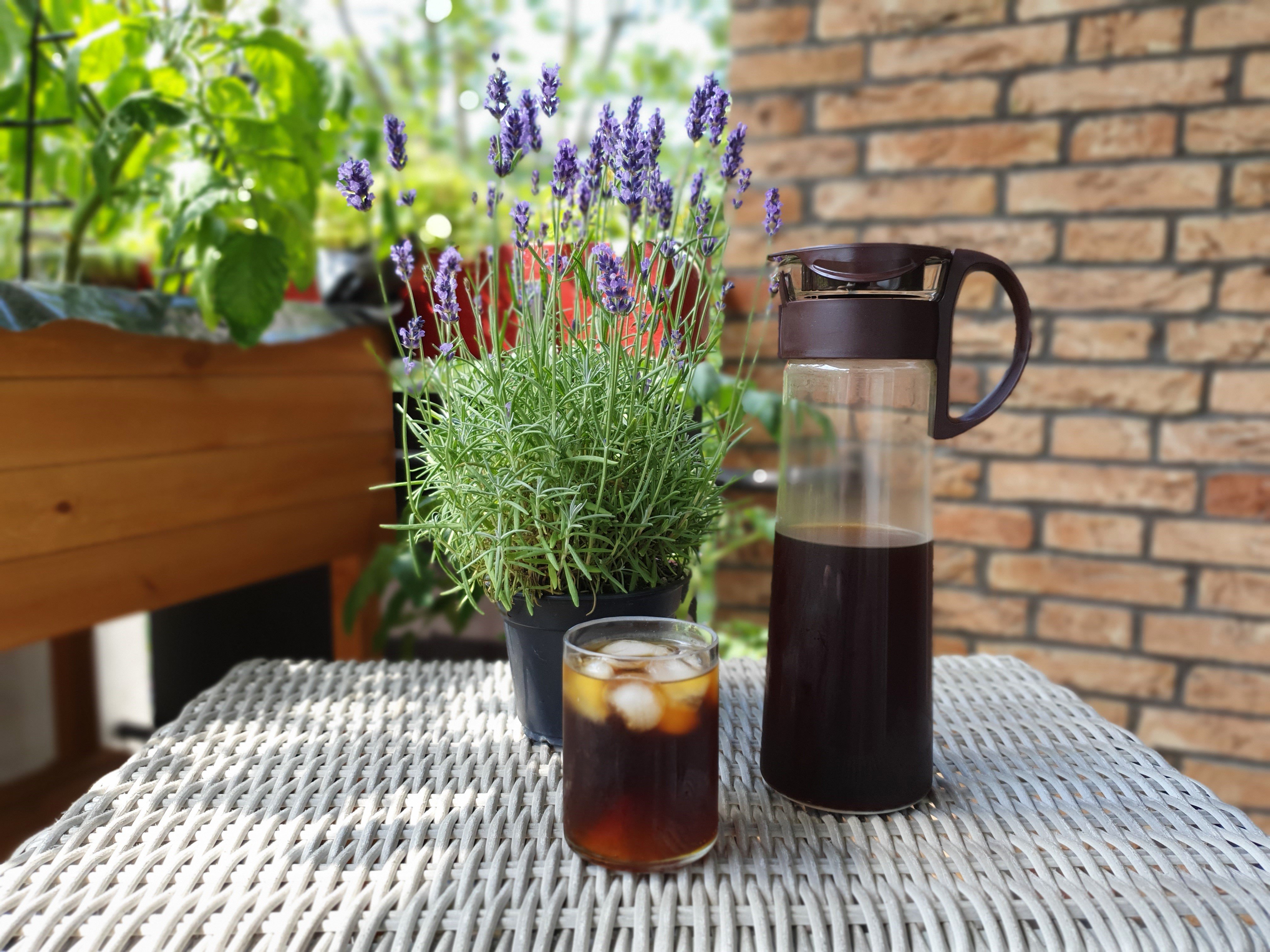
Cold Brew Coffee
- Prep. Time: 15 minutes
- Total Time: 15 minutes (plus 16 hours resting time)
- Yield:4-5 cups of coffee
The excellent thing about this cold brew coffee recipe is that it is super easy, and produces delicious coffee every time.
We’ll be using 3 ounce (85g) of coffee to 1 quart (1L) of water, which will give us around 4 or 5 cups of tasty cold brew coffee, ready to drink. We love the Hario Mizudashi, so we’ll be using that for the recipe. Feel free to use a 1-quart wide-mouth mason jar or a French press of the same size if you don’t have one of these.
Ingredients
What you'll need
Instructions
Weigh and coarsely grind coffee
Combine coffee and water
Gently stir after 5 minutes and make sure all coffee particles are wet
Put a lid on and steep for 16 hours in the refrigerator
Take out of the refrigerator and separate liquid coffee from the grinds (decant). Use a paper filter or a clean cloth if brewing in a mason jar
Let it rest for 3-5 minutes
Enjoy your own cold brew coffee! It will stay fresh for up to 10 days in the fridge
If you want to recreate those delicious milky bottled cold brews that you see in cafes, or cut your cold brew coffee with tonic water, your best bet is to make a cold brew concentrate. To make a concentrate, follow the same steps mentioned above, but instead of a 1:12 coffee to water ratio, use a 1:5 ratio — 7 1/4 ounces (200g) of coffee to 1 quart (1L) of water.
Detailed Brewing Steps
First of all, measure and grind the coffee. We’re looking at getting our coffee around the same texture as raw sugar or kosher salt. Don’t stress too much about it, just don’t go too fine, as small particles might clog your filter.
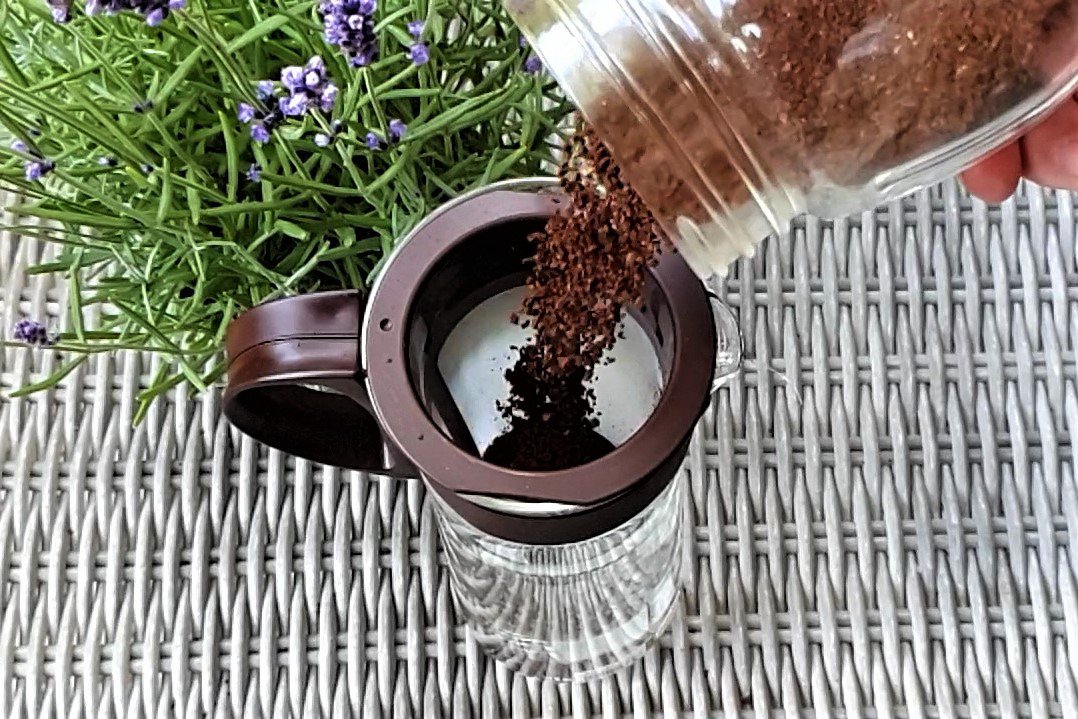
Add the coffee to the brewer.
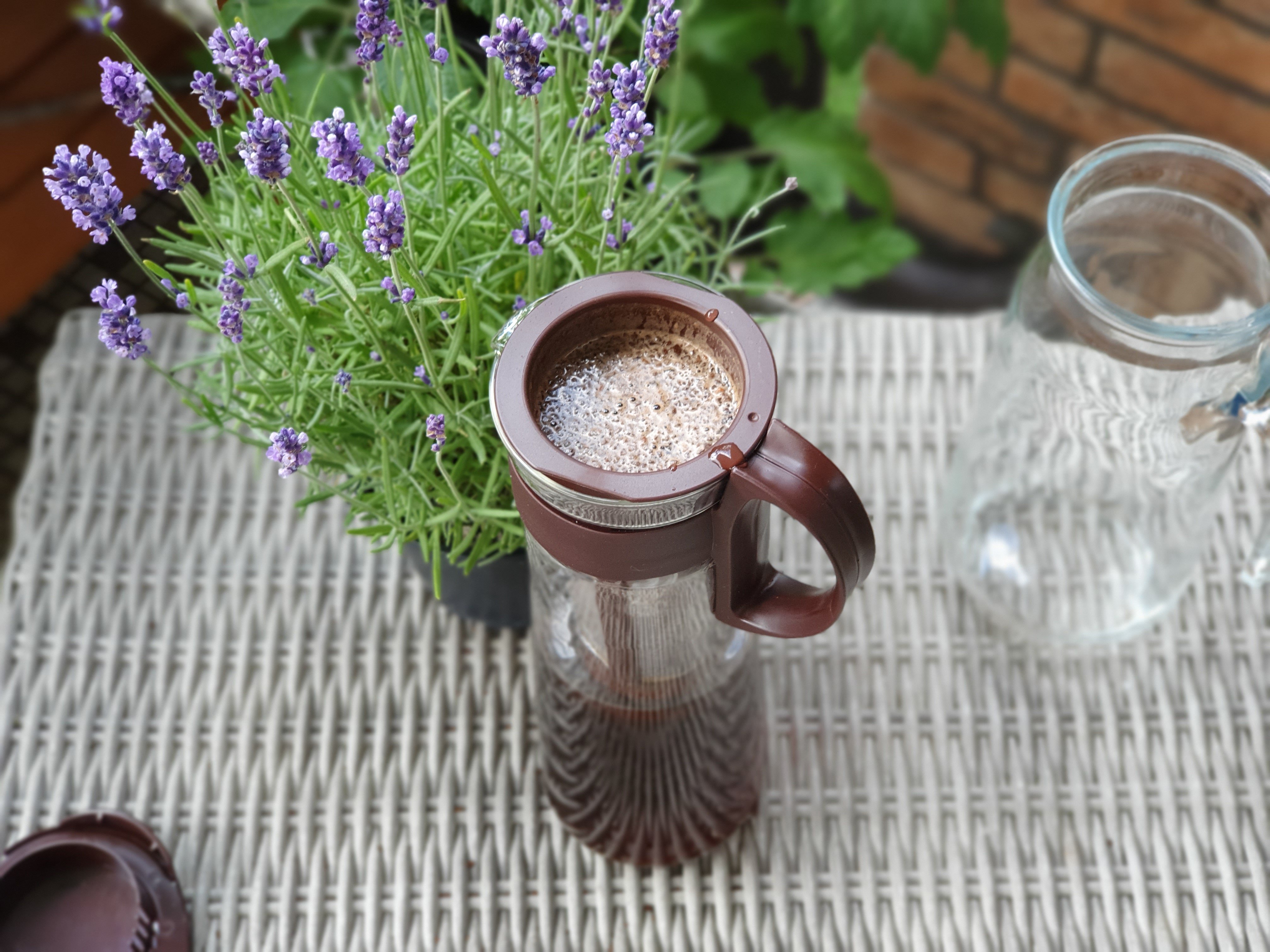
Slowly pour the cold water over the coffee. Make sure you get everything nice and wet. Don’t stir the mixture as this can clog the filter — just make sure everything is included in the pool party.
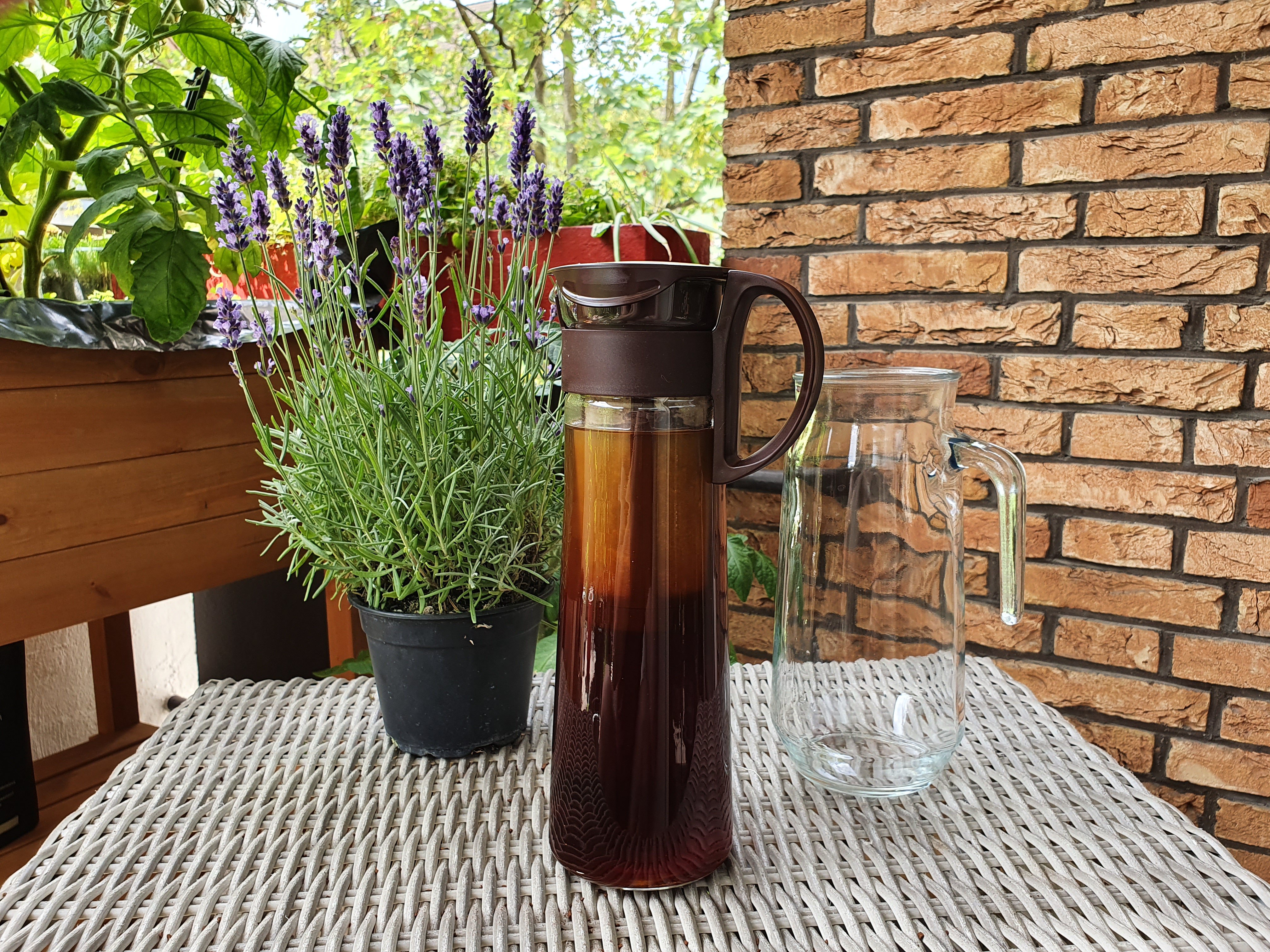
Place the lid on or cover the brewer. Store this in the fridge for about 16 hours (14 hours is ok, so is 18.) If you have no space in the refrigerator, just put it on the kitchen counter away from direct sunlight or too much heat.
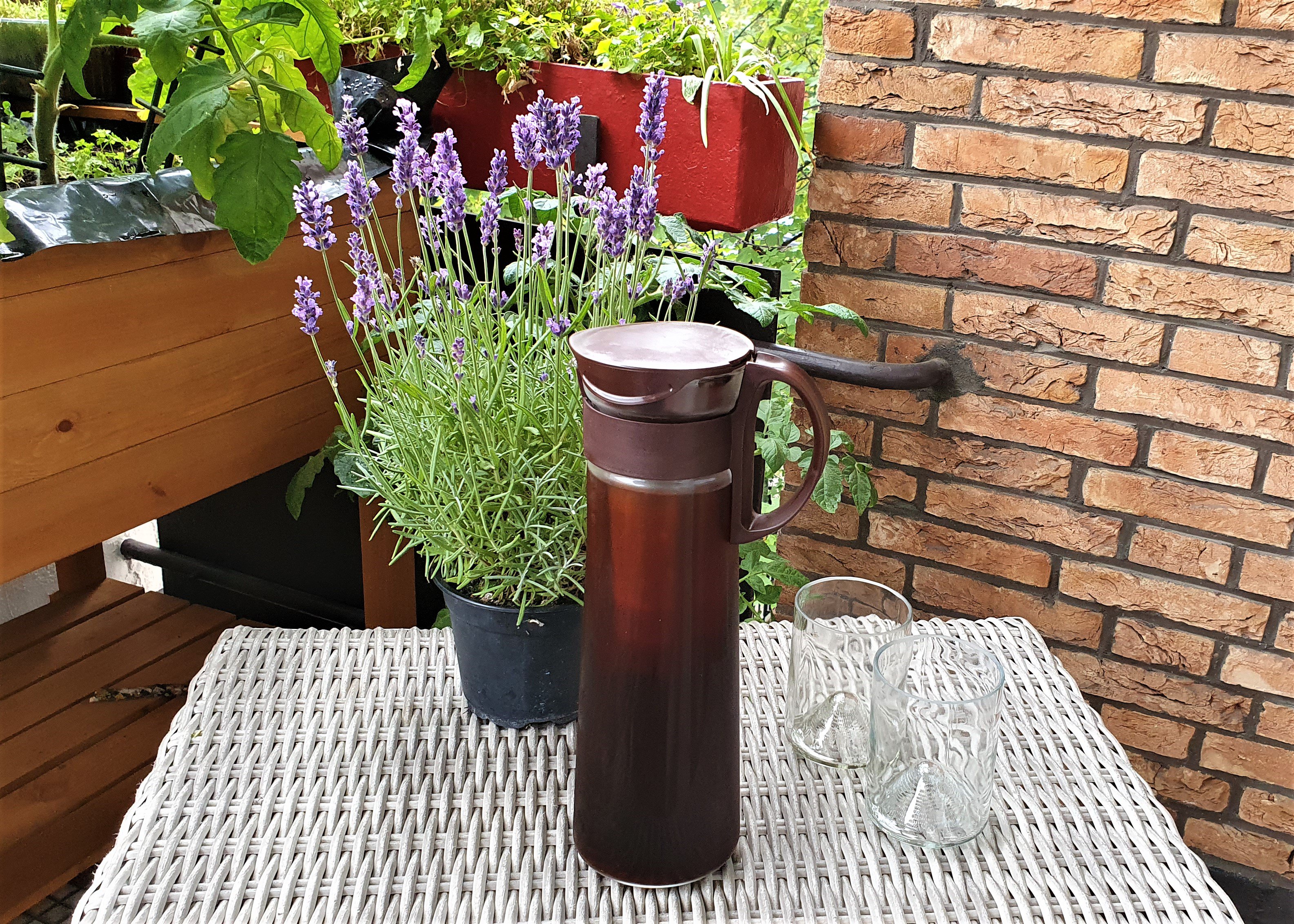
After 16 hours, take your brewer out of the refrigerator.
Now all we need to do is separate the coffee grinds from the liquid. If using a cold brew coffee system, follow the instructions on your brewer. If using a mason jar, pour the entire mixture through your chosen filter and decant your cold brew. If you went with a French press, press down the plunger and decant the cold brew in another container.
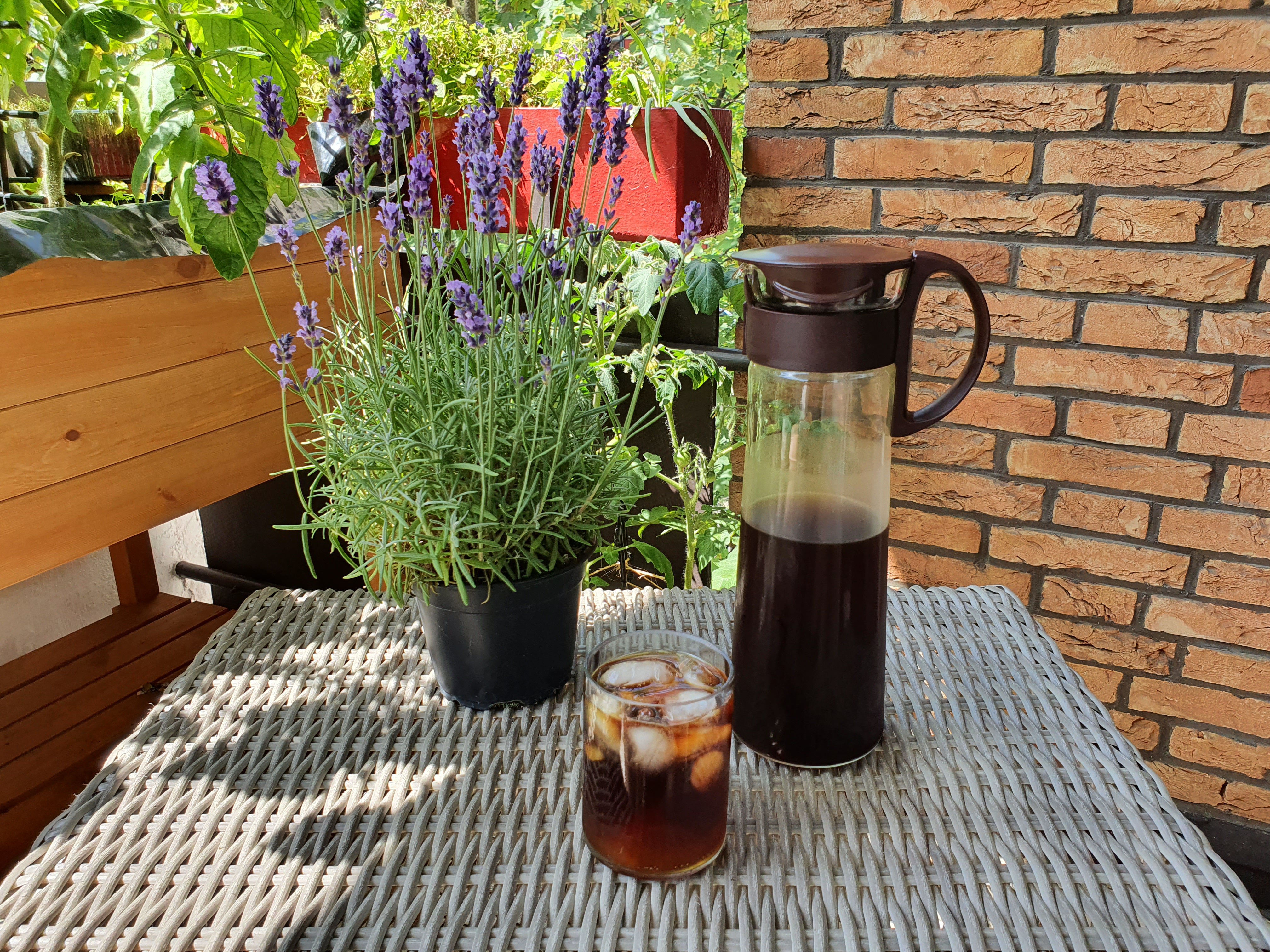
Enjoy your tasty cold brew over ice! This cold brew coffee should stay delicious in the fridge for around 10 days.
Tip: Cold brew coffee can be super DIY. You can use pretty much any container you like to brew a batch — a bowl, a mug, a bucket, a mason jar, a water bottle...anything! Just make sure that it is fully covered with either a lid or cling wrap before placing it into the fridge.
How to Make Cold Brew Coffee in a Mason Jar
Want to whip up a batch of homemade cold brew coffee, but all you have is a mason jar? You’re in luck, because that’s all you need!
Add 3 ounces (85g) of coffee to the jar, then pour in 1 quart (1L) of cold water. If your jar is smaller, no worries. Just stick to the 1:12 coffee to water ratio. Only have a 500ml jar? Use 1.5 ounces (42g) of ground coffee to 2 cups (500 ml) of water. Ensure all the coffee is wet. Screw on the lid and let this steep in the fridge for 16 hours. After 16 hours, take the jar out of the fridge and pour the entire contents through your chosen filter (V60, Chemex, cloth filter). Enjoy your delicious mason jar cold brew coffee!
Grinding coffee for cold brew
We’re big fans of hand coffee grinders. They are inexpensive and offer excellent grind quality for the money. The Hario Skerton Plus a good budget option. The only issue is that grinding 80 grams in a hand grinder takes a bit of time, not to mention effort. If you are making large batches of old brew, consistently, and you don’t want to end up with one massive bicep, you might want to go for an electric grinder like the famous Baratza Encore.
Products We Love That Will Elevate Your Cold Brew Experience
While you absolutely can make cold brew coffee in a mason jar, or any of the other DIY vessels we’ve mentioned, if you find yourself brewing a batch or two weekly, you might want to look at a specialized cold brew coffee maker. Not only are they reasonably priced, but they produce a much finer, cleaner coffee in the cup, all the while making your job a whole lot easier. We are currently into the Hario Mizudashi and the OXO Brew compact.
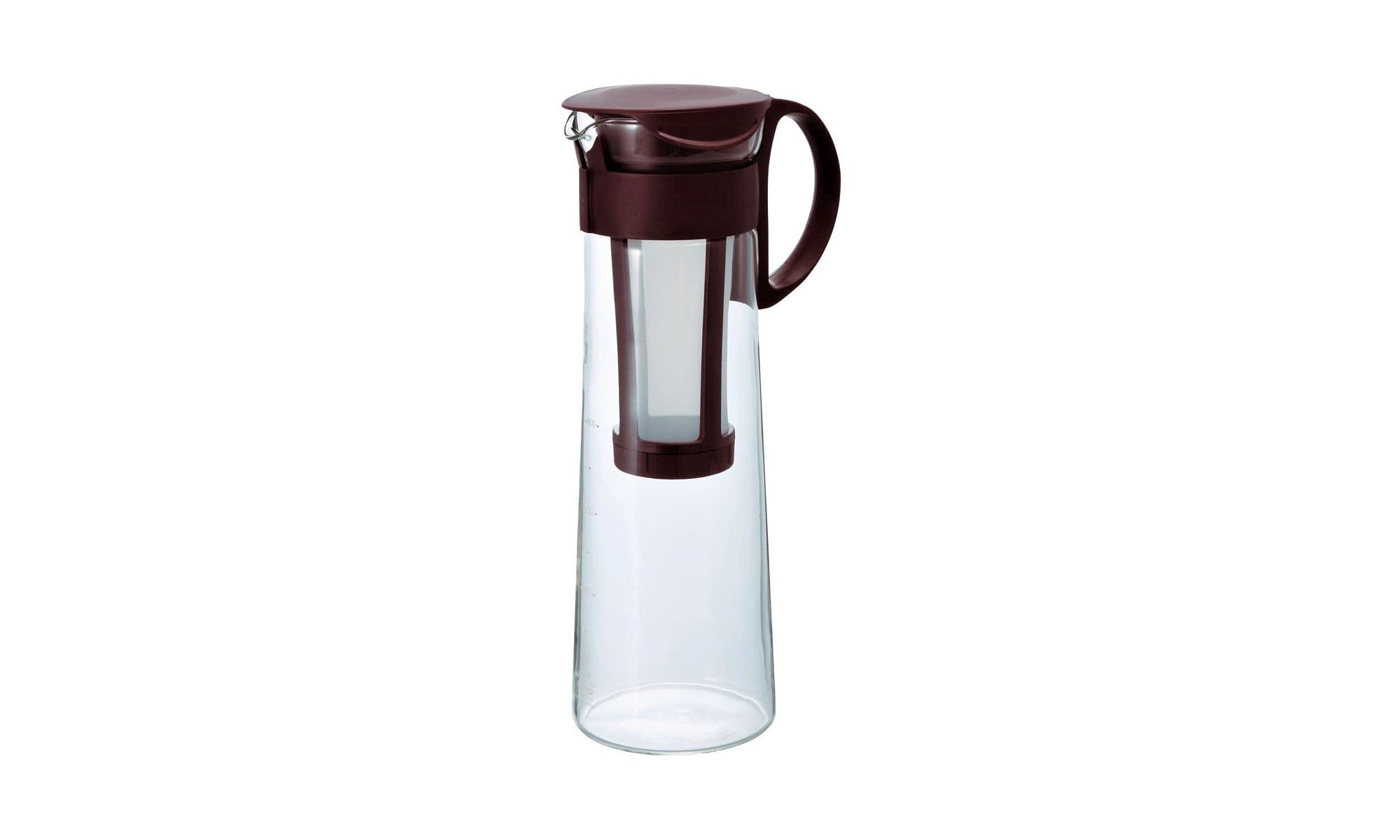
It’s no secret that we love almost everything Hario. And the Mizudashi is no exception. The beauty of the Hario Mizudashi, and one of the reasons why we love it as we do, is that it's so easy to use. Add coffee, add water, and let it steep. Once the coffee is nicely extracted, remove the grinds basket and you’re ready to drink! Not only is the Mizudashi easy to use, but it’s also incredibly easy to clean, fits neatly on most refrigerator doors, and when you’re done brewing, the coffee is served directly out of the bottle. The Mizudashi has a 1-quart capacity (1L), which will brew around 4-5 cups of ready to drink cold brew coffee. It also comes in a smaller 2.5 cup (600ml) size.
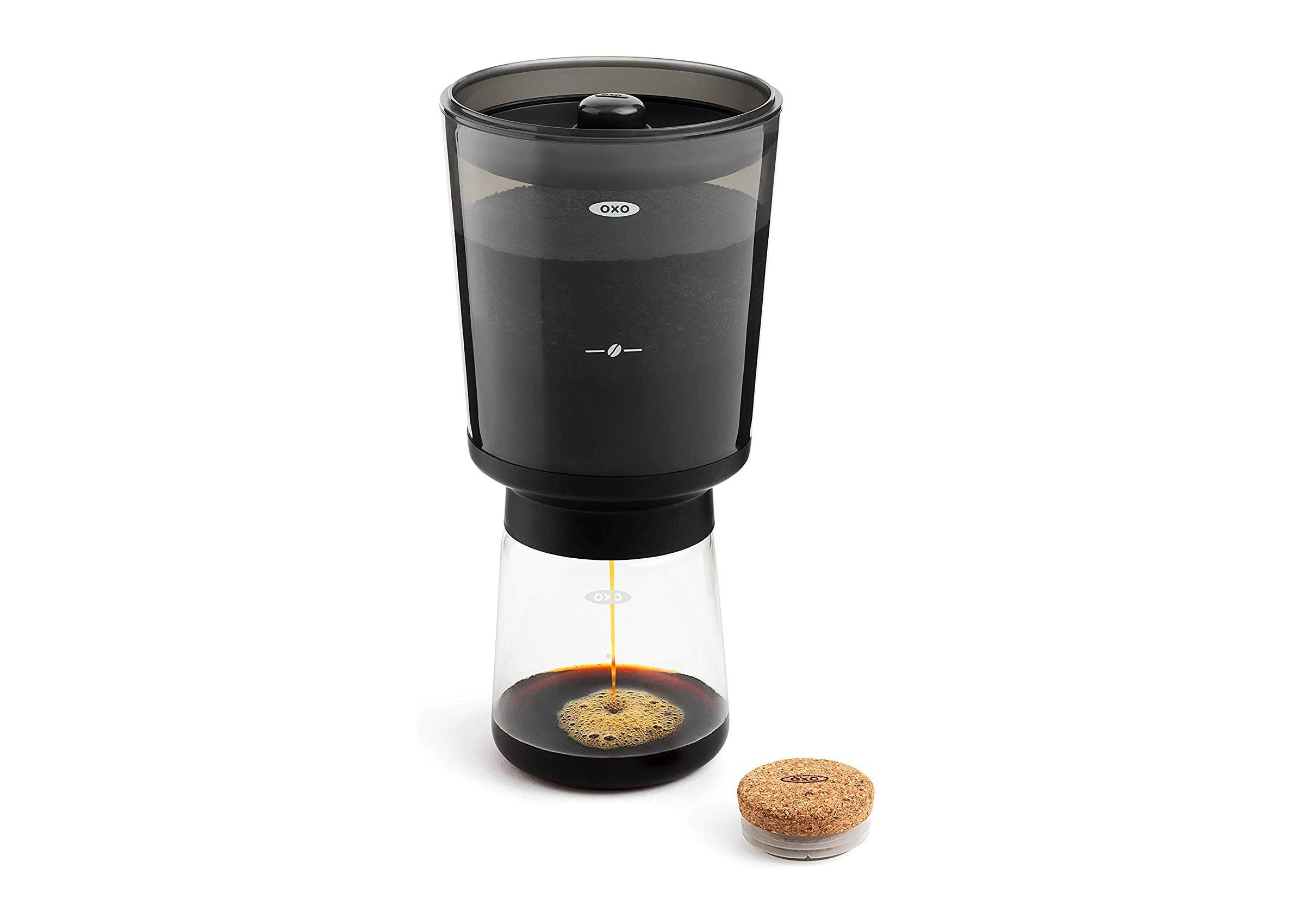
It’s not the first time an OXO product has made one of our top picks as far as coffee gear is concerned — the OXO POP storage container did quite well in our coffee storage container shoot-out.
The OXO brew compact is a sort of modern twist on the classic Toddy cold brew coffee system. Coffee is added to the brew chamber before water is added, and then the brewer is placed either in the fridge or on the countertop. Once the 16-hour brew is done, place the brewer atop the carafe and the coffee will automatically drain. Simple to use, easy to clean, and comes with a nice, borosilicate glass carafe with a tight sealed lid. What more could a cold brew lover need?
Iced Coffee vs Cold Brew. Why not Just Add Ice to Hot Coffee?
Much of the coffee community is divided here — as Shakespeare once said, ‘To cold brew, or to iced coffee? That is the question!’
On one side, we have the cold brew camp — die-hard lovers of brewing with cold water, happy to leave the acidity and the bitterness in the dust. On the other, we have people who love to brew their coffee hot — think that heat is essential, and are more than happy to chill a hot brew using ice — these people generally feel bitterness and acidity are essential to a fully rounded cup of coffee.
I’m a regular visitor to both camps. I love them both.
Let’s take a quick look at why we can’t just throw some ice into a hot brew.
The main issue is dilution. If we add enough ice to hot coffee to make it cold, the ice will melt, and the resulting coffee will be so watered down that there will be little coffee flavor left. To avoid this, we have two options. We could leave a hot brew to cool down in the fridge, but this will just taste like cold but old and stale hot coffee.
The other option is to brew an iced pour-over, also known as Japanese iced coffee. This method solves the problem of dilution in a similar way as cold brew concentrate — by using less water and more coffee. Iced pour-overs are an entire article on their own, so we won’t get into it too heavily here and now.
If we’re being honest though, the two flavors are so different that there is room at the table for both.
Personally, if I feel like a cold coffee with milk, I’ll go for a cold brew concentrate. If I’m in the mood for some acidity, something super bright and cool, I’ll go for an iced pour-over. But if I’m making coffee for a bunch of friends, without a doubt I’ll whip out that ready to drink cold brew.
Different Types of Cold Brew and How You Can Use Them
There are three main types of cold brew coffee. Each has its own unique flavor and is best for a particular thing.
Cold Drip
Unlike a batch of cold brew, cold drip coffee keeps its water and coffee separate, only allowing single droplets of water (at a rate of about 1 drop per second) to drip over the coffee. These droplets eventually add up, fully soaking the ground coffee before dripping into the decanter below. Like cold brew, cold drip is low in acidity and bitterness. The cold drip brewing technique takes somewhere between two and twelve hours, depending on the volume of coffee being brewed, resulting in a lighter coffee with a bright kind of feel, best consumed cold and over ice.
Ready to Drink Cold Brew
Ready to drink cold brew is a classic immersion brewing technique. It presents a coffee that is quite similar to cold drip, but is heavier both in body and in flavor. It is excellent to drink as is, and because it is a little stronger than cold drip, thanks in large part to it’s long 16 hour brew time, it goes well with a splash of something (milk, tonic or soda) to give it a special little kick.
Cold Brew Concentrate
Cold brew concentrate is the inevitable heavyweight of the three kinds of cold water brewing. Because cold brew uses around three times the amount of coffee, we’re left with a rich and full coffee, very strong in both flavor and caffeine. Most people don’t drink cold brew concentrate on its own— it’s generally cut at a 1:1 ratio with something else. Cocktails including cold brew coffee have become popular, thanks to its rich, smooth flavor. It is not uncommon for cold brew concentrate to be mixed with hot water, making a smooth, low acid hot coffee for those with sensitive tummies.
New Orleans Style Cold-Brew Coffee
The process of making New Orleans style cold brew is very similar to that of cold brew concentrate, with the only difference being the addition of roasted chicory in with the ground coffee. The chicory gives the coffee a nutty, warm quality that goes well with raw sugar and milk, over ice.
“If your cold brew starts to taste off, some of your plants might want it! Dilute it with 2 parts water, 1 part cold brew. Water plants that prefer a slightly acidic soil like roses, begonias, and ferns. Just don’t overdo it.”
by Brent Wolczynski of Stumptown Coffee
Best Coffee for Cold Brew
One of the great things about cold brew is that it isn’t fussy. Because there is no heat involved in the brewing process, we get to leave many of the unpleasant notes that would make a coffee too bitter, behind. This really means that the best coffee to use for cold brew, is simply a coffee that has tasting notes that match your preference.
To keep it simple, the following is a pretty good rule of what I’ve found works quite well.
Best Coffee For Cold Brew Concentrate
- For cold brew concentrate to mix with milk, try a medium roasted coffee that is full of chocolate or caramel notes. In my experience, light fruity coffees don’t mix too well with milk, nor do they have the strength to cut through the flavor of the milk. Espresso blends can also work well.
- For cold brew concentrate to drink with soda, tonic, or water, go for a light to medium roasted coffee with fruit-forward notes.
Best Coffee For Ready to Drink Cold Brew
- Light roasts work really well for ready to drink cold brew and cold drip. I personally love to use fruity African coffees, or a naturally processed coffee when making ready to drink cold brew.
Have a bag of coffee that’s past its freshness peak?
One of the first things to go when a good coffee loses freshness is acidity. Acidity is something that really makes a fresh coffee stand out— that sparkling acidity. Because cold brew generally leaves acidity behind anyway, this coffee need not go to taste. We can use these not-so-fresh beans to make a batch or two of cold brew concentrate!
The Best Additions to Any Cold Brew Concentrate
Now we’ve got our delicious cold brew concentrate and we’re finally ready to get mixing! While the possibilities are endless, here are a few of the classic additions that will complement your tasty cold brew. All are best cut at a ratio of about 1:1, and served over ice.
- Milk
- Oatly Barista edition oat milk (it’s so good that you won’t believe it’s non-dairy milk)
- Soy milk (bonsoy is the best, hands down)
- Water (clean and odor-free)
- Tonic. Absolutely delicious, love it.
- Soda water. Super refreshing.
Cold Brew FAQ
How long does cold brew coffee last?
Up to 10 days in the refrigerator. If you add anything to the cold brew itself, like sugar syrup or flavorings, it’s best to use it within 2 or 3 days.
How much caffeine is there in cold brew?
Around 160mg per 8oz cup. This largely depends on the coffee you use, the ratio you use, and how much you dilute your concentrate. For more info on how this 160mg number came about, head over to the SCA for a cold brew caffeine content analysis.
Do you put sugar in cold brew coffee?
Most cold brew coffees that are mixed with milk or soda will have a dash of simple sugar syrup added, just to give it that ‘iced coffee’ kick. In general, sugar is not added to ready to drink cold brew.
Is cold brew stronger than regular coffee?
When properly diluted, the strength of cold brew concentrate ends up about the same as hot coffee. Cold brew concentrate is definitely stronger.
Can you use regular coffee for cold brew?
Absolutely. That’s one of the best things about cold brew. Any coffee that you like, you can use for cold brew.
Summary
Cold brew coffee is such a fun form of brewing, perfect for experimenting with not only different coffees, but different flavor additions. So how do you cold brew? What is your favorite cold brew addition? Have you hacked and DIY’d your way to deliciousness? Let us know, we’d love to hear about your caffeinated adventures!